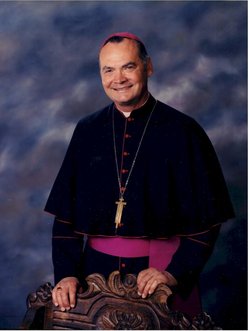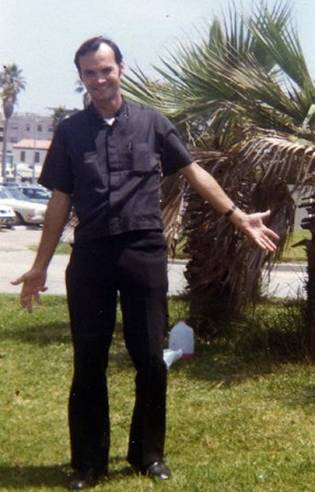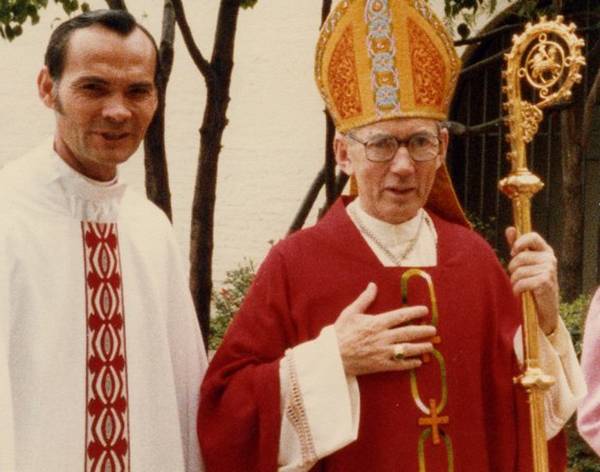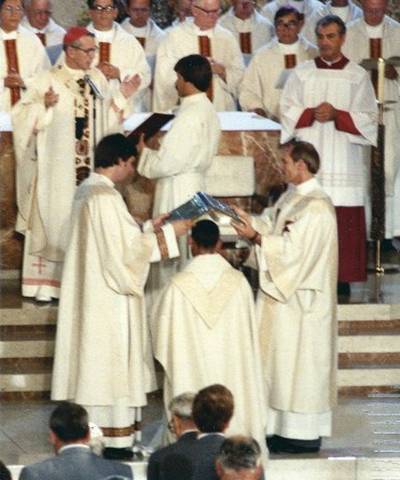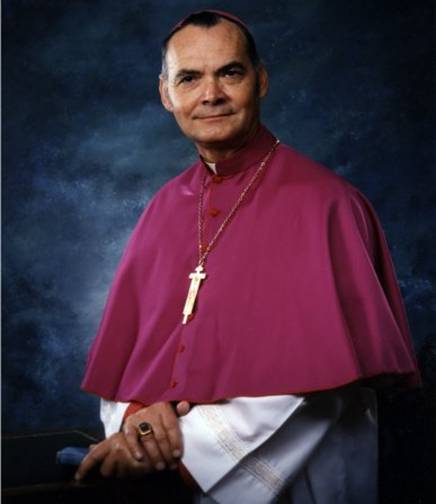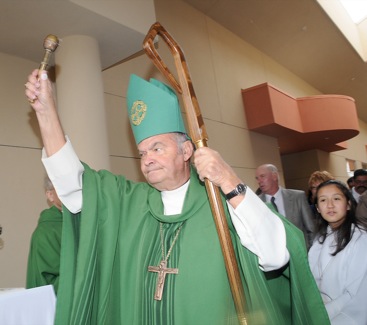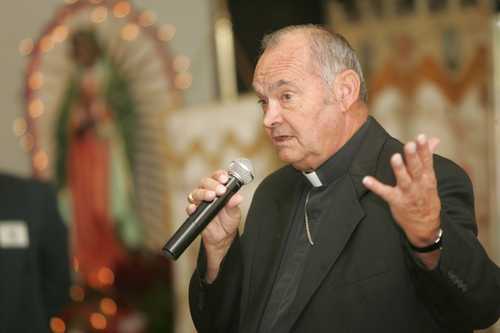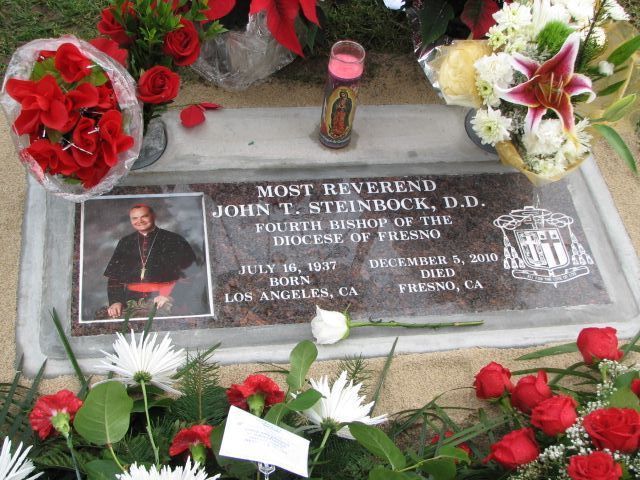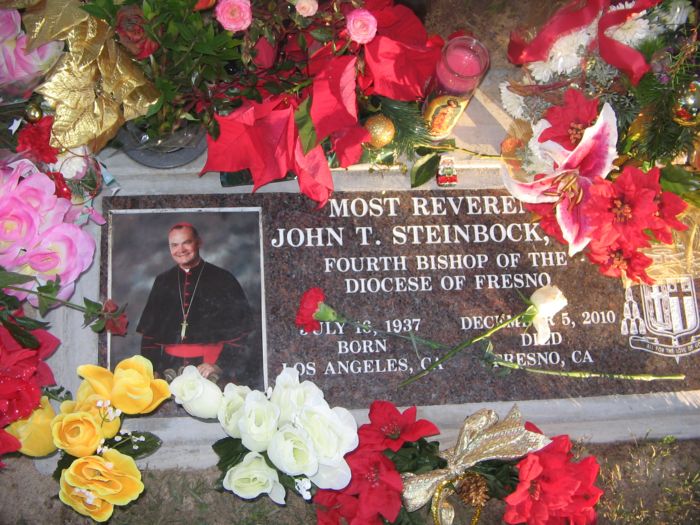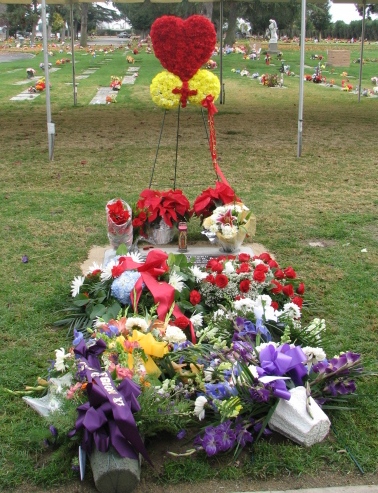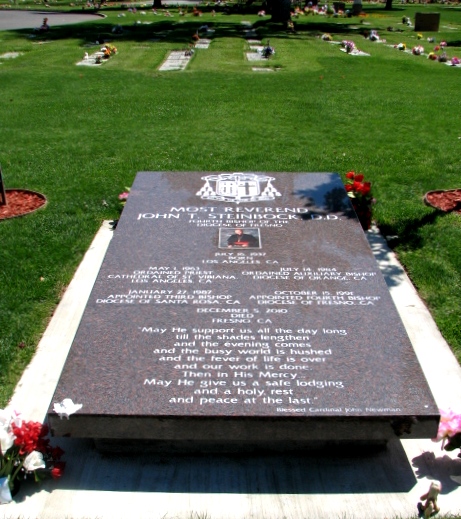"I learned to read reading a racing form," Bishop Steinbock said in a 2002 interview with 'The Bee'. "I learned to count playing blackjack."
As a kid, he played sports, got into some fights, and was shy but came out of his shell when he had to. His parents had to pressure him to attend Mass because he thought the service boring.
He was one of three boys in the family -- and all became priests. (One later left the priesthood.)
He said his brothers' decisions to wear the Roman collar pointed him toward the priesthood. He attended a rigorous college-prep high school designed for young men considering the priesthood, and graduated in 1955, before enrolling in a Seminary College.
He sometimes wondered whether God really wanted him to become a priest, Bishop Steinbock said in the 2002 interview.
In the summer of 1958, while learning Spanish at a boardinghouse in Mexico City, he shared space with young men who frequented bars. Watching them, he decided he would rather become a priest.
"What was important to them ... would've been material things in life," he said. "I just felt like, 'Hey, what does the world need most of all? The Lord Jesus and his love and his truth.' "
In 1963, fresh out of St. John's Seminary in Camarillo, he was assigned to Resurrection parish in Los Angeles, in the Hispanic barrio. He was ordained on May 1, by Cardinal James McIntyre.
There he began to develop his reputation as an administrator, a skill his superiors valued and one that commended him to promotion in the hierarchy.
Initially, East L.A. was a culture shock for someone from a middle-class background. He spent late nights around the kitchen tables of his parishioners, where they would drink coffee, smoke cigarettes and talk into the early morning.
In 1973, Bishop Steinbock was transferred to St. Vibiana's Catholic Cathedral near Skid Row. Each night, 2,000 men and women slept on the surrounding streets and alleys.
In 1983, near the end of his time in downtown Los Angeles, he wrote a poem about the despair he had encountered on Skid Row. Two evocative lines read: "Hopeless persons seeking the cold damp warmth for a place to sleep. Senseless persons searching for meaningless pleasure."
He said he would have been content to stay a priest, but the late Cardinal Timothy Manning had other ideas, engineering his rise in the church. In 1984, Manning told him that the Pope had named him an Auxiliary.
He didn't want to accept it. But he said Manning told him the Pope was simply acting in accordance with God's will for Bishop Steinbock's life.
At 47 years of age, Steinbock received his episcopal consecration with the Titular See of Midila, from Cardinal Manning, assisted by Bishops William Robert Johnson and Manuel Duran Moreno.
His first assignment as Bishop was in Orange County, serving mainly as vicar general and diocesan administrator, from 1984 until January 27, 1987, when he was named Bishop of the Diocese of Santa Rosa in California, succeeding Msgr. Mark Joseph Hurley, who had resigned his office the previous April, following his appointments to Vatican Congregation of Education and the Secretariat for Non-Believers.
On October 15, 1991, Steinbock was appointed the Fourth Bishop of the Diocese of Fresno, succeeding Msgr. José de Jesús Madera Uribe M.Sp.S., who was transferred to the Military Ordinariate of the United States of America.
Monsignor Steinbock led the Diocese of Fresno through nearly two decades of growth and controversy. He died at 3.10 am., surrounded by family, his pastor and friends at Saint Agnes Medical Center, on Sunday, December 5, 2010, aged 73.
Bishop Steinbock announced in August of that years, that he had lung cancer. He was admitted to Saint Agnes in early November after complaining of shortness of breath and lack of energy. Tests revealed he had a blood clot in his right lung and others in his legs. In 2009, he was treated for facial cancer.
Bishop Steinbock's death came on the same day as downtown Fresno's annual Our Lady of Guadalupe procession and Mass, over which he usually presided.
Viewing and Rosary were held at St. John's Cathedral, 2814 Mariposa St. in downtown Fresno, while funeral services were celebrated at St. Anthony of Padua, 5770 N. Maroa Ave., Fresno. Interment followed at St. Peter's Cemetery, 264 N. Blythe Ave.
"I learned to read reading a racing form," Bishop Steinbock said in a 2002 interview with 'The Bee'. "I learned to count playing blackjack."
As a kid, he played sports, got into some fights, and was shy but came out of his shell when he had to. His parents had to pressure him to attend Mass because he thought the service boring.
He was one of three boys in the family -- and all became priests. (One later left the priesthood.)
He said his brothers' decisions to wear the Roman collar pointed him toward the priesthood. He attended a rigorous college-prep high school designed for young men considering the priesthood, and graduated in 1955, before enrolling in a Seminary College.
He sometimes wondered whether God really wanted him to become a priest, Bishop Steinbock said in the 2002 interview.
In the summer of 1958, while learning Spanish at a boardinghouse in Mexico City, he shared space with young men who frequented bars. Watching them, he decided he would rather become a priest.
"What was important to them ... would've been material things in life," he said. "I just felt like, 'Hey, what does the world need most of all? The Lord Jesus and his love and his truth.' "
In 1963, fresh out of St. John's Seminary in Camarillo, he was assigned to Resurrection parish in Los Angeles, in the Hispanic barrio. He was ordained on May 1, by Cardinal James McIntyre.
There he began to develop his reputation as an administrator, a skill his superiors valued and one that commended him to promotion in the hierarchy.
Initially, East L.A. was a culture shock for someone from a middle-class background. He spent late nights around the kitchen tables of his parishioners, where they would drink coffee, smoke cigarettes and talk into the early morning.
In 1973, Bishop Steinbock was transferred to St. Vibiana's Catholic Cathedral near Skid Row. Each night, 2,000 men and women slept on the surrounding streets and alleys.
In 1983, near the end of his time in downtown Los Angeles, he wrote a poem about the despair he had encountered on Skid Row. Two evocative lines read: "Hopeless persons seeking the cold damp warmth for a place to sleep. Senseless persons searching for meaningless pleasure."
He said he would have been content to stay a priest, but the late Cardinal Timothy Manning had other ideas, engineering his rise in the church. In 1984, Manning told him that the Pope had named him an Auxiliary.
He didn't want to accept it. But he said Manning told him the Pope was simply acting in accordance with God's will for Bishop Steinbock's life.
At 47 years of age, Steinbock received his episcopal consecration with the Titular See of Midila, from Cardinal Manning, assisted by Bishops William Robert Johnson and Manuel Duran Moreno.
His first assignment as Bishop was in Orange County, serving mainly as vicar general and diocesan administrator, from 1984 until January 27, 1987, when he was named Bishop of the Diocese of Santa Rosa in California, succeeding Msgr. Mark Joseph Hurley, who had resigned his office the previous April, following his appointments to Vatican Congregation of Education and the Secretariat for Non-Believers.
On October 15, 1991, Steinbock was appointed the Fourth Bishop of the Diocese of Fresno, succeeding Msgr. José de Jesús Madera Uribe M.Sp.S., who was transferred to the Military Ordinariate of the United States of America.
Monsignor Steinbock led the Diocese of Fresno through nearly two decades of growth and controversy. He died at 3.10 am., surrounded by family, his pastor and friends at Saint Agnes Medical Center, on Sunday, December 5, 2010, aged 73.
Bishop Steinbock announced in August of that years, that he had lung cancer. He was admitted to Saint Agnes in early November after complaining of shortness of breath and lack of energy. Tests revealed he had a blood clot in his right lung and others in his legs. In 2009, he was treated for facial cancer.
Bishop Steinbock's death came on the same day as downtown Fresno's annual Our Lady of Guadalupe procession and Mass, over which he usually presided.
Viewing and Rosary were held at St. John's Cathedral, 2814 Mariposa St. in downtown Fresno, while funeral services were celebrated at St. Anthony of Padua, 5770 N. Maroa Ave., Fresno. Interment followed at St. Peter's Cemetery, 264 N. Blythe Ave.
